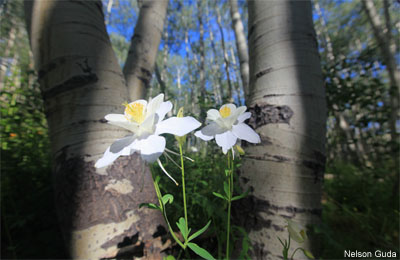Protect America's Great Outdoors: Co-Sponsor the National Forest Roadless Area Conservation Act of 2011 (Senate)
The proposed legislation would protect millions of acres of national forest lands but would do so in a pragmatic way.
 The National Forest Roadless Area Conservation Act of 2011, proposed for introduction by Reps. Jay Inslee (Wash.), Maurice Hinchey (N.Y.), Ed Markey (Mass.), Diana DeGette (Colo.) and Raúl M. Grijalva (Ariz.), would provide long-term protection to America's last wild national forests. With more than half of the country's national forests open to logging, mining, drilling and other development, this measure provides a balanced approach to ensure that the remainder will be preserved for future generations to enjoy. We urge you to become an original co-sponsor of this important bill to safeguard roadless national forests and the clean water, valuable fish and wildlife habitat, and outdoor recreation opportunities they provide.
The National Forest Roadless Area Conservation Act of 2011, proposed for introduction by Reps. Jay Inslee (Wash.), Maurice Hinchey (N.Y.), Ed Markey (Mass.), Diana DeGette (Colo.) and Raúl M. Grijalva (Ariz.), would provide long-term protection to America's last wild national forests. With more than half of the country's national forests open to logging, mining, drilling and other development, this measure provides a balanced approach to ensure that the remainder will be preserved for future generations to enjoy. We urge you to become an original co-sponsor of this important bill to safeguard roadless national forests and the clean water, valuable fish and wildlife habitat, and outdoor recreation opportunities they provide.
Summary of the Bill
The National Forest System consists of more than 193 million acres in 42 states. Roadless areas make up 58.5 million acres of national forest lands in 38 states, including Alaska's Tongass National Forest, the core of North America's largest temperate rain forest. The National Forest Roadless Area Conservation Act of 2011 would give these areas the same protections provided by the popular Roadless Area Conservation Rule, issued in 2001 to replace the patchwork of management regulations that left old-growth and other ecologically valuable stands vulnerable.1 Like the original roadless rule, the proposed legislation recognizes the ecological and economic importance of these areas by placing them off limits to most commercial logging and road-building. However, the bill does not institute a complete ban on road construction and other development. Rather, it offers a pragmatic approach to preserving forest land as it:
- Allows road construction to fight fires, address forest health and protect public safety.
- Allows logging of certain timber to reduce the risk of wildfires.
- Allows the expansion of oil and gas operations within existing or renewed leased areas.
- Allows road construction to accommodate hardrock mining.
In addition, the bill does not close any existing roads or trails or affect private property rights or access.
A people without children would face a hopeless future; a country without trees is almost as helpless.President Theodore Roosevelt
Why are National Forest Roadless Areas Important?
According to the U.S. Forest Service, national forest roadless areas serve as the prime source of clean drinking water for almost 60 million Americans.2 They also provide valuable fish and wildlife habitat for more than 1,600 threatened or endangered plant and animal species3 and generate a significant portion of the outdoor industry's $730 billion in revenue each year.4 Additionally, protecting roadless areas is fiscally responsible, because it allows the Forest Service to address the estimated $10 billion backlog in road maintenance instead of using taxpayer dollars to subsidize new roads.5
What's at Risk?
Some members of Congress are trying to take away protections that have existed for decades, including safeguards for our unspoiled backcountry.
The Wilderness and Roadless Area Release Act (H.R. 1581), introduced by House Majority Whip Kevin McCarthy (Calif.), would open more than 60 million acres of pristine national forests and other wild lands—an area the size of Wyoming—to development. As a result, roughly 70 percent of America's most valuable landscapes and waterways could be degraded through industrial development.
More than 100 years ago, President Theodore Roosevelt set forth a vision for America's public lands by establishing the National Forest System to provide valuable fish and wildlife habitat, clean drinking water for millions of people, and unparalleled outdoor recreation opportunities for all to enjoy. In his appreciation of our national forests, he said: “A people without children would face a hopeless future; a country without trees is almost as helpless.”
We urge you to become an original co-sponsor of the National Forest Roadless Area Conservation Act of 2011 so that we can permanently protect these last remaining wild places for generations to come.
For more information, please contact:
Robert C. Vandermark I 202-887-8848 I [email protected]
Geoffrey Brown I 202-887-8806 I [email protected]
For additional resources, visit us at www.PewEnvironment.org
View the House Dear Colleague Letter, Roadless Area Conservation Act of 2011 (PDF).
Endnotes:
1 Federal Register 66(9). Jan. 12, 2001. Rules and Regulations, p. 3246.
2 See usgovinfo.about.com/blroadless.htm.
3 See www.fs.usda.gov/Internet/FSE_DOCUMENTS/fsm8_035777.pdf.
4 See www.outdoorindustry.org/images/researchfiles/RecEconomypublic.pdf?26; www.outdoorindustry.org/national-economic-impact-reports.php.
5 See www.ourforests.org/fact/tcs040104.pdf; www.ourforests.org/fact/tcsnatlrelease040104.pdf.
.pdf.











